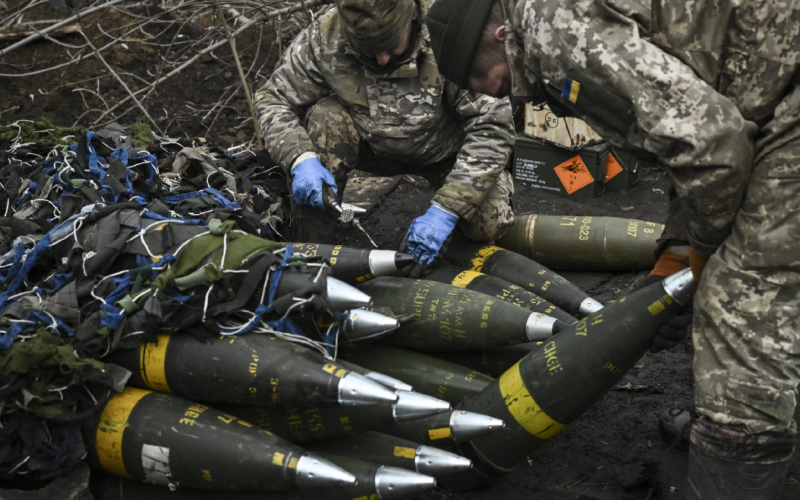On its sprawling 800km frontline, Russia is preparing for a decisive battle.
As the sloppy winter mud begins to dry, Russia is preparing for a decisive battle across its front, which is three lines deep in places.
Kyiv wants to seize the initiative and beat back the invader after an underwhelming Russian offensive achieved limited results last year.
But Moscow has learned from past failures and is once again counting on a long, grinding war it believes it can win.
Russia’s fortifications extend from Kherson in the south all the way to northeastern Ukraine, a stretch of some 800 km.
Ukrainian attacks will come up against several successive obstacles, Brady Africk, of the think-tank American Enterprise Institute, told AFP.
Russia has “layers of fortifications and trenches”, he said. “This includes anti-tank ditches, barriers, pre-made defence lines like ‘dragon’s teeth’ and trenches for men.”
“The goal for the Russians is to take the hit,” added Pierre Razoux, Academic Director of the Mediterranean Foundation for Strategic Studies (FMES).
“In the second curtain, the attacker tends to get stuck and even if he passes, the third is frankly complicated.”
Where Ukraine will hit is shrouded in secrecy and could still be undecided.
Wishing to throw Moscow off the scent, Kyiv may launch a “small-scale attack” as “a decoy”, explains Andrew Galer, an analyst at Britain’s Janes Institute.
This could cause Russia to divert its defensive resources away from the main target, meaning Ukrainian troops will encounter less resistance.
Vassily Kashin, of Moscow’s National University, suggests the Bakhmut region is one option, which has seen heavy fighting for months. But he admits: “The data we have is very limited.”
On Monday, the boss of Russia’s Wagner mercenary group Yevgeny Prigozhin predicted a counter-offensive on the day his fighters seize Bakhmut, pointing to 9 May that marks the Russian victory over Nazi Germany in World War Two.
Since the start of the war, the Kremlin has relied on its large pool of soldiers, with some claiming conscripts are being used as cannon fodder against a better-equipped Ukrainian force.
Despite suffering heavy losses, successive recruitment campaigns, notably last year’s partial mobilisation, have brought more Russian troops to the front.
“Even [if] exhausted by its effort, [Russia] will still have enough reserves of men to help absorb the shock” of a Ukrainian assault, wrote Philippe Gros and Vincent Tourret, in a study by the Foundation for Strategic Research (FRS).
“They have put in place enough counter-mobility measures to significantly complicate any Ukrainian advance.”
There are widespread claims that many Russian conscripts, drawn from the far-flung corners of the country, have been rushed through training and are woefully underprepared for battle.
Yet, even poorly trained reservists can hold the line, suggested AFP.
“No Ukrainian offensive, even the most effective, will put an end to this war,” said Kashin from Moscow’s National University.
Flush with Western equipment, Kyiv is better armed than it was a year ago.
However, many promised weapons have not made it to the frontlines yet, while Ukrainian equipment has also been destroyed.
“A high level of losses [have been] generated by the war of attrition, in particular among the most experienced officers and soldiers,” notes the FRS, adding there is a “drastic constraint on the consumption of ammunition”.
Further complicating Ukraine’s war effort it is also juggling between old weapons from the Soviet period and cutting-edge Western arms, making logistics and training critical.
Breaking through enemy lines is only valuable if the conquered area can be held.
“The further [the Ukrainians] go in reclaiming territory, the longer the supply chain is,” warns Andrew Galer.
Kyiv worries that the West may grow tired of supplying arms to Ukraine, though many capitals have promised to do whatever it takes to help them win.
“He has no room for error. He can only act when he is sure of his shot”, says Pierre Razoux.
Meanwhile, as it prepares to go on the offensive, Ukraine must also still defend a list of priorities: Kyiv, Kharkiv, and the supply lines between the two cities, its border with Belarus, Odesa, besides its civilian nuclear power plants.
Ex-colonel turned historian Michel Goya says “only two breakthroughs have been achieved in this war: in Popasna by the Russians in May 2022 and especially in the province of Kharkiv by the Ukrainians in September”.
“The positions of both sides, especially the Russian side, are currently much stronger than they were at the time,” he adds.
Source: EuroNews









